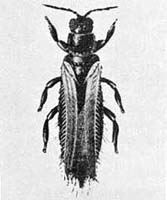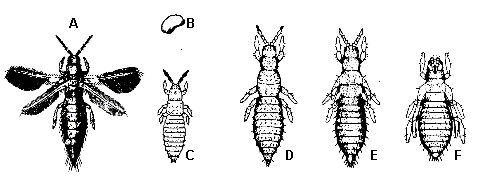|
|
Back to Pest Identification and Diagnosis
GLADIOLUS THRIPS
SCIENTIFIC NAME:
Thrips simplex (Morison)
CLASS:
Insecta
ORDER:
Thysanoptera
FAMILY: Thripidae
 |
 A. Adult B. Egg C-D. Larvae E. Prepupa F. Pupa |
|
Adult Female Gladiolus Thrips From: University of Florida |
Life Cycle From: NC Extension |
| DESCRIPTION | |
|
Adults: Gladiolus thrips emerge milky-white, but soon turn dark brown, except for the apical portions of the legs which are lighter. The wings, brown apically and lighter basally, appear to be darker with a grey band when folded over the back. This thrips is about 1.5 to 1.65 mm long. Males are smaller slightly smaller and lighter in color than the females. Eggs: The eggs are opaque, white, kidney-shaped, and about 0.34 mm long and 0.2 mm in diameter. Larvae: The larvae of the gladiolus thrips are light or pale yellow with red eyes and are about 1.0 mm long when fully developed. Pupae and Prepupae: The pupae move only when disturbed and develop through 2 instars. The first instar (prepupa) has short wing pads and the antennae project forward. The second instar (pupa) has long wing pads and the antennae are folded back onto the head. Both stages are dark orange with red eyes and about 1.2 mm in length. |
|
| BIOLOGY | |
|
Distribution: Gladiolus thrips is now found wherever gladioli are grown. However, it cannot overwinter out-of-doors in northern Europe and northern North America. Host Plants: The gladiolus thrips most seriously damages gladioli, but is also a pest of iris, carnation, lily, narcissus, freesia, amaryllis, tigerflower, poker plant, tomato, begonia, primula, snapdragon, chrysanthemum, and geranium. Damage: Plants severely infested with gladiolus thrips have a spotted, bleached appearance (see Color Plate). Both leaves and petals are fed upon and appear withered. If flower buds are seriously damaged, the flowers fail to open. The entire plant may become stunted. Life Cycle: Gladiolus thrips are believed to be an introduced pest from Africa, where gladioli are native. The thrips are brought into previously uninfested fields or greenhouses on infested corms. These rather sluggish thrips can overwinter at any stage on stored corms or on plants growing in greenhouses. Although the gladiolus thrips can maintain a population outside during the summer, they cannot overwinter outside in areas where the temperature consistently falls below 10° C. These thrips have six stages in their life cycle: the egg, two larval instars, two pupal instars and the adult stage. Females deposit 100 to 200 eggs. Many times females greatly out-number the males in a population and parthenogenesis occurs. Parthenogenetic females produce eggs that develop into males. Temperature greatly determines the duration of each stage. During the warm growing season the development of the gladiolus thrips can occur in about 2 weeks. With such rapid development, the thrips can have nine or more generations outside during the growing season. The eggs are deposited in the leaves of gladioli or in the corms in storage. Larvae and pupae can be found in the buds or leaf sheaths, although the larvae often drop to the ground to transform into the quiescent pupae. Adult gladiolus thrips live 35 to 40 days. |
Back to Pest Identification and Diagnosis
 |
(C) Regents of the University of
Minnesota. All rights reserved. |
 |
 |